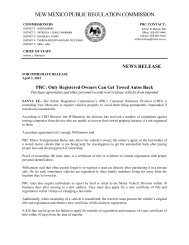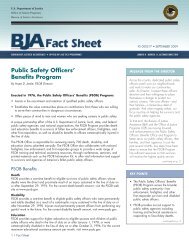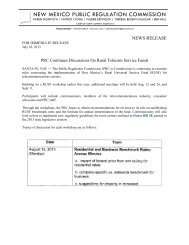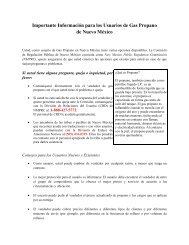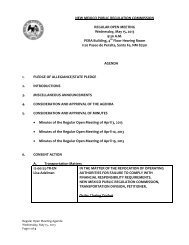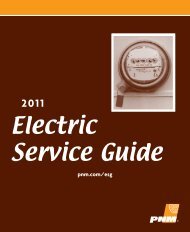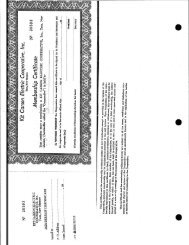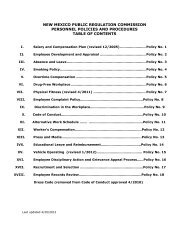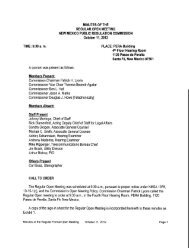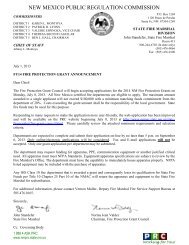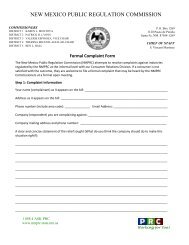Slamming & Cramming Protection - New Mexico Public Regulation ...
Slamming & Cramming Protection - New Mexico Public Regulation ...
Slamming & Cramming Protection - New Mexico Public Regulation ...
You also want an ePaper? Increase the reach of your titles
YUMPU automatically turns print PDFs into web optimized ePapers that Google loves.
TITLE 17CHAPTER 13PART 8PUBLIC UTILITIES & UTILITY SERVICESTELECOMMUNICATIONSSLAMMING AND CRAMMING PROTECTION (INTERIM)1. ISSUING AGENCY: <strong>New</strong> <strong>Mexico</strong> <strong>Public</strong> <strong>Regulation</strong> Commission (“Commission”), 224East Palace Avenue, Santa Fe, <strong>New</strong> <strong>Mexico</strong> 87501. [7-1-99]2. SCOPE: This rule applies to every provider or seller of telecommunications services, billingaggregator, and billing agent which is subject to the jurisdiction of the <strong>Public</strong> <strong>Regulation</strong>Commission as provided by state or federal law, including all employees, officers, affiliates,and agents of any such person or entity. [7-1-99]3. STATUTORY AUTHORITY: The <strong>New</strong> <strong>Mexico</strong> <strong>Slamming</strong> and <strong>Cramming</strong> Act, Laws 1999Ch. 138, the <strong>New</strong> <strong>Mexico</strong> Constitution, art. II, § 2, the <strong>New</strong> <strong>Mexico</strong> <strong>Public</strong> <strong>Regulation</strong> Act,NMSA 1978 sections 8-8-4, and 8-8-15(C), NMSA 1978 section 63-7-1.1(A)(2), the <strong>New</strong><strong>Mexico</strong> Telephone and Telegraph Company Certification Act, NMSA 1978 section 63-9-1 etseq., the <strong>New</strong> <strong>Mexico</strong> Telecommunications Act, NMSA 1978 section 63-9A-1 et seq., theCellular Telephone Services Act, NMSA 1978 section 63-9B-1 et seq., and the RuralTelecommunications Act of <strong>New</strong> <strong>Mexico</strong>, Laws 1999 Ch. 295. [7-1-99]4. DURATION: Temporary, until permanent rules are adopted pursuant to NMSA 1978section 8-8-15(B). [7-1-99]5. EFFECTIVE DATE: July 1, 1999, unless a later date is cited at the end of a section orparagraph. [7-1-99]6. OBJECTIVE: The purpose of this rule is to establish standards and procedures toinvestigate and resolve allegations of unauthorized telecommunications charges(“cramming”) and unauthorized changes in telecommunications service providers(“slamming”). This rule shall be liberally construed to carry out its intended purposes. [7-1-99]7. DEFINITIONS: As used in this rule:7.1. “Authorization” means a letter of agency or oral agreement which meets therequirements of these rules; [7-1-99]7.2. “Billing agent” means any local exchange company or any person that submits bills fortelecommunications charges or telecommunications services to a customer; [7-1-99]7.3. “Billing aggregator” means a person that bills customers for goods or services providedby others and that uses a local exchange company as a billing agent; [7-1-99]17 NMAC 13.8<strong>Slamming</strong> and 1<strong>Cramming</strong> <strong>Protection</strong>
7.4. “Clear and conspicuous” when used in regard to notification or language means noticethat would be reasonably apparent to an average customer or language that would bereasonably understandable to an average customer, provided that this definition shall notbe construed to assume that an “average” customer will have any degree of expertise orsophistication regarding telecommunications services or charges; [7-1-99]7.5. “Commission or NMPRC” means the <strong>New</strong> <strong>Mexico</strong> <strong>Public</strong> <strong>Regulation</strong> Commission; [7-1-99]7.6. “<strong>Cramming</strong>” means:7.6.1. charging a customer for telecommunications services that were not authorized bythe customer;7.6.2. charging a customer for goods or services on a customer’s telephone bill that arenot telecommunications services; or7.6.3. using a sweepstakes, contest or drawing entry form as authorization to change oradd telecommunications services to a customer’s telephone bill;[7-1-99]7.7. “Customer” means the individual whose name appears on the telephone bill, theindividual responsible for payment of the telephone bill, or a household member or otherindividual previously designated in writing by the individual responsible for payment ofthe telephone bill as being authorized to make decisions concerning telecommunicationscharges or changes in provider. In the case of a corporation, business trust, estate, trust,partnership, limited liability company, association, joint venture, or any legal orcommercial entity, customer means the individual previously designated in writing bythe organization, corporation or other entity as responsible for payment of the telephonebill, or other decisions about telecommunications charges or changes intelecommunications service providers. No authorization designations allowed under thisdefinition shall be effective unless contained in the account records of the local exchangecompany as of the date any charge or change in provider is made; [7-1-99]7.8. “Local exchange company” means a provider that provides local exchange services; [7-6-99]7.9. “Local exchange services” means the transmission of two-way interactivecommunications within a local exchange area described in maps, tariffs or rate schedulesfiled with the commission where local exchange rates apply; [7-1-99]17 NMAC 13.8<strong>Slamming</strong> and 2<strong>Cramming</strong> <strong>Protection</strong>
7.10. “<strong>New</strong> provider” is any provider, including a reseller of long distance services, that didnot bill for services on the customer’s last previous telephone billing statement; [7-1-99]7.11. "Person" means an individual, corporation, business trust, estate, trust, partnership,limited liability company, association, joint venture or any legal or commercial entity;[7-1-99]7.12. “Provider” means a local exchange company, telephone company, transmissioncompany, telecommunications common carrier, telecommunications company, cellularor other wireless telecommunications service company, cable television service,telecommunications reseller, billing aggregator or other person that bills directly or has abilling contract with a local exchange company; [7-1-99]7.13. “Seller” means a provider or other person that sells telecommunications services; [7-1-99]7.14. “<strong>Slamming</strong>” means:7.14.1. changing a customer’s telecommunications service provider without thecustomer’s authorization; or7.14.2. using a sweepstakes, contest or drawing entry form as authorization to change acustomer’s telecommunications service provider;[7-1-99]7.15. “Telecommunications service” means the transmission of signs, signals, writings,images, sounds, messages, data or other information of any nature by wire, radio,lightwaves or other electromagnetic means or goods and services related to thetransmission of information that are provided by the provider; provided that a good orservice that does not meet the definition of “telecommunications service” does notbecome a telecommunications service merely because it is bundled with atelecommunications service for marketing or billing purposes. [7-1-99]8. RELATIONSHIP TO OTHER COMMISSION RULES: Unless otherwise specified, thisrule is not intended to supersede any other rule of the Commission but to supplement suchrules. Nevertheless, if any provision of this rule is inconsistent with the provisions of anyother Commission rule, the provisions of this rule shall apply. [7-1-99]9. PROHIBITED ACTS9.1 Any person that changes or causes a customer’s telecommunications service provider orservice to be changed without obtaining the customer’s authorization in accordance with17 NMAC 13.8<strong>Slamming</strong> and 3<strong>Cramming</strong> <strong>Protection</strong>
these rules is guilty of “slamming” and shall be subject to appropriate penalties asprovided by law. [8-16-99]9.2 Any person that places or causes a charge for telecommunications services to be placedon a customer’s telephone bill without having obtained the customer’s authorization inaccordance with these rules is guilty of “cramming” and shall be subject to appropriatepenalties as provided by law. [8-16-99]9.3 Any person who places or causes a charge to be placed on a customer’s telephone bill forgoods or services which are not telecommunications services is guilty of “cramming”and shall be subject to appropriate penalties as provided by law. [8-16-99]10. CUSTOMER AUTHORIZATIONS10.1 Customer authorization of any charge or change in provider on the customer’s telephonebill shall not be valid unless:10.1.1 such authorization is contained in a letter of agency separate from any sales orsolicitation material and which contains, in clear and conspicuous language, a fulland complete description of any change process, including the identity of any newprovider, and any charge for any product or service on the customer’s bill. Theletter of agency shall also contain, in clear and conspicuous language, 1) a full andcomplete description of the rates, fees and charges associated with any newprovider and any product or service on the customer’s telephone bill, 2) thecustomer’s name and billing address, 3) a notation of each telephone number to becovered by any change in provider, 4) if applicable, a statement that the customerintends to change from one provider to another, and 5) a statement that thecustomer knows that there may be a charge for the change in service. At aminimum, the letter of agency must be printed with a type of sufficient size andreadable type to be clearly legible, comparable to the type size and style used inany promotional materials accompanying the sales/marketing offer. The letter ofagency shall be signed by the customer before any change may be made in acustomer’s provider, and before any charge for any product or service may beplaced on a customer’s bill; or10.1.2 such authorization is obtained pursuant to an oral agreement where the provider orseller originating the charge or change of provider records the entirety of any andall communications or conversations with the customer leading to suchauthorization, including all terms and conditions of any such charges or change inprovider. Customer authorizations obtained pursuant to an oral agreement shallonly be valid if the provider or seller originating the charge or change in providerprovides the customer with a full and complete description of the rates, fees and17 NMAC 13.8<strong>Slamming</strong> and 4<strong>Cramming</strong> <strong>Protection</strong>
[8-16-99]charges associated with any new provider and any product or service on thecustomer’s telephone bill. The customer’s authorization pursuant to an oralagreement shall be obtained before any change may be made in a customer’sprovider, and before any charge for any product or service may be placed on acustomer’s bill.10.2 Customer authorization of any charge or change in provider or service on a customer’stelephone bill that does not comply with the requirements of these rules shall be voidand without effect, except that authorization is not required for charges related to the useof customer-initiated “dial-around” services such as “10-10-XXX”, directory assistance,operator-assisted calls, and acceptance of collect calls. [8-16-99]10.3 Customer authorization of any charge or change in provider or service on a customer’stelephone bill shall be void and without effect if obtained using a sweepstakes, contest,or drawing entry form. [8-16-99]11. INFORMATION ON CUSTOMER TELEPHONE BILLS11.1 Any charge or change in provider shall be indicated on the customer’s telephone bill inclear and conspicuous language and easily legible type. [8-16-99]11.2 Any person that places or causes a charge to be placed on a customer’s telephone bill,and any person that changes or causes a customer’s provider to be changed shall:11.2.1 clearly and conspicuously identify the name of the provider associated with eachcharge or change of provider on the telephone bill;11.2.2 include a brief, clear and conspicuous description of the product, service, orchange in provider to be placed on the customer’s bill, including the amountcharged for each product, service, or change in provider or service (includingtaxes and surcharges). The description must be sufficiently clear in presentationand specific enough in content so that customers can accurately assess that theservices for which they are billed correspond to those that they have requestedand received, and that the costs assessed for those services conform to theirunderstanding of the price charged;11.2.3 clearly and conspicuously display on each bill a toll-free number or numbers bywhich customers may inquire or dispute any charge contained on the bill. Thetoll-free number or numbers shall, at a minimum, be staffed during normalbusiness hours with personnel able to provide sufficient information as necessaryto respond to and resolve customer inquiries concerning any charge, service, or17 NMAC 13.8<strong>Slamming</strong> and 5<strong>Cramming</strong> <strong>Protection</strong>
change in provider on a customer’s bill, provided that after normal business hoursa customer is able to leave a recorded message on a 24-hour per day basisconcerning any inquiry or complaint regarding unauthorized charges or changesin provider on the customer’s telephone bill. If a customer’s call to the toll-freenumber is recorded after normal business hours, the provider or its agent staffingthe number must call the customer back by the end of the next business day andkeep trying for three days. If the customer cannot be reached in three days, aletter must be sent to the customer stating that the contact could not be made andproviding the toll-free number and operating hours when the customer may reachpersonnel able to assist the customer with resolving questions or complaintsregarding unauthorized charges or changes in provider. A provider may list a tollfreenumber for a billing agent, clearinghouse, or other third party, provided thatsuch party possesses sufficient information to answer questions concerning thecustomer’s account and is fully authorized to resolve customer complaints on theprovider’s behalf. Each provider must make its business address available uponrequest to customers through its toll-free number; and11.2.4 where charges or changes for two or more providers appear on the same telephonebill, separate such charges and provide clear and conspicuous notification of anychange in provider, including notification to the customer that a new provider hasbegun providing service.[8-16-99]11.3 Where a customer’s telephone bill contains charges for local exchange service, inaddition to other charges, the bill must distinguish between charges for which nonpaymentwill result in disconnection of basic local exchange service, and charges forwhich non-payment will not result in such disconnection. The local exchange carrier orits billing agent must clearly and conspicuously identify on the customer’s telephone billthose charges for which non-payment will not result in disconnection of basic localexchange service. [8-16-99]11.4 At least two times per year at regular intervals, the local exchange company or otherbilling agent shall deliver to each customer a bill stuffer or separate mailing which 1)explains procedures for resolving customer complaints concerning unauthorized chargesor changes in provider on the customer’s telephone bill, 2) includes the Commission’stoll-free telephone number where customers can obtain assistance with resolvingdisputed charges or changes in provider, and 3) advises the customer of their right to beabsolved of liability for any unauthorized charges or changes in provider for a period of90 days. [8-16-99]12. RESOLUTION OF CUSTOMER COMPLAINTS AND DISPUTES17 NMAC 13.8<strong>Slamming</strong> and 6<strong>Cramming</strong> <strong>Protection</strong>
12.1 A customer may contact his or her local exchange company, authorized provider, or theunauthorized provider to report an unauthorized charge or change of provider. Anyprovider contacted by a customer concerning a disputed charge or change in providershall notify the local exchange company about the disputed charge or change in provideror service within 24 hours. [8-16-99]12.2 Upon receipt of notification by a customer, another provider, or the local exchangecompany of a disputed charge or change in provider on a customer's bill, a provider andany billing agent shall immediately cease all efforts to collect payment for the disputedcharge or change. [8-16-99]12.3 Customer complaints concerning disputed charges or changes in provider must besubmitted to the Consumer Relations Division of the Commission Staff in writing. Toexpedite resolution of the complaint, the customer shall provide the Commission Staffwith the following information:12.3.1 a copy of the bill with the disputed charge or change in provider;12.3.2 a brief discussion of any unauthorized charge or change in provider, including thedollar amount under dispute;12.3.3 a brief discussion outlining the attempts made to resolve the disputed charge orchange in provider;12.3.4 the names and telephone numbers of the provider or providers contacted by thecustomer, and the approximate date of any such contact.[8-16-99]12.4 Upon receipt of a customer complaint concerning a disputed charge or change inprovider, the Commission Staff shall mail a copy of the customer’s complaint to theprovider responsible for originating the disputed charge or change in provider, alongwith a request for verification of the customer’s authorization of such charge or changein provider. To aid the Commission Staff in expediting resolution of complaints, eachprovider shall provide the Commission with the name, address, and telephone number ofthe appropriate individual or department designated to assist in resolving customercomplaints concerning slamming and cramming. [8-16-99]12.5 Within 14 days of the date on which Staff mails the notification of a customercomplaint to any provider, the provider originating the disputed charge or change inprovider shall submit verification to Staff of the customer’s authorization of any suchcharge or change in provider in the form required under these rules. [8-16-99]17 NMAC 13.8<strong>Slamming</strong> and 7<strong>Cramming</strong> <strong>Protection</strong>
12.6 Upon receipt of verification of a customer’s authorization of any disputed charge orchange in provider, the Commission Staff shall review such verification and make adetermination concerning whether the authorization meets the requirements of theserules. [8-16-99]12.7 Once the Commission Staff makes a determination concerning whether a disputedcharge or change in provider was authorized by the customer in accordance with theserules, Staff shall promptly mail its determination to the customer and the provideroriginating the disputed charge or change in provider of its determination. If thecustomer wishes to contest Staff’s initial determination concerning the customer’sauthorization of the disputed charge or change in provider, the customer shall have 30days from the date Staff’s initial determination is mailed in which to submit anyadditional evidence or information it believes should be considered by Staff and theCommission in making its final determination concerning the customer’s authorizationof the disputed charge or change in provider. The Staff shall promptly mail any suchadditional information or evidence submitted by the customer to the provider. [8-16-99]12.8 If the customer contests Staff’s initial determination concerning the customer’sauthorization of any disputed charge or change in provider by submitting information orevidence contesting the genuineness or authenticity of the customer’s authorizationsubmitted to Staff by the provider pursuant to section 12.5, within 15 days of the dateStaff mails any such information to the provider, the provider may submit any additionalevidence which may be necessary to establish the authenticity or genuineness of thecustomer’s authorization of the disputed charge or change in provider, provided that theprovider’s right to submit such additional evidence shall not be construed to allowsubmission of the initial proof of customer authorization required under section 12.5 ofthis rule. [8-16-99]12.9 After the time period for submission of addition evidence or information concerning thecustomer’s authorization of a disputed charge or change in provider has expired, or uponreceiving written notification that the customer or the provider does not wish to submitsuch additional evidence, Staff shall make a final determination concerning thecustomer’s authorization of the disputed charge or change in provider in accordancewith these rules. [8-16-99]12.10 In making its final determination concerning the customer’s authorization of adisputed charge or change in provider, Staff shall presume that a disputed charge orchange in provider was not authorized whenever:12.10.1 any provider fails to provide verification of customer authorization to theCommission Staff in the form and manner required under these rules; or17 NMAC 13.8<strong>Slamming</strong> and 8<strong>Cramming</strong> <strong>Protection</strong>
12.10.2 the Commission Staff determines that there is a lack of sufficient evidenceconfirming that the customer authorized any charge or change in provider inaccordance with these rules.[8-16-99]12.11 After receipt of notification of Staff’s final determination concerning the customer’sauthorization of a disputed charge or change in provider, if either the customer or theprovider wishes to contest Staff’s final determination it shall file a written appeal ofStaff’s determination with the Commission within 14 days. Thereafter, the Commissionwill review the evidence submitted in the course of Staff’s investigation and issue anOrder upholding or reversing Staff’s final determination. Where appropriate, theCommission in its discretion may choose to assign a Hearing Examiner to conduct ahearing and take further evidence and testimony as the Commission deems necessary toreach a final determination concerning the customer’s authorization of the disputedcharge or change in provider. [8-16-99]12.12 If no party files an appeal of Staff’s final determination on the disputed charge orchange in provider within the 14 day period provided for in these rules, Staff’sdetermination shall become final and have the same force and effect as a finalCommission Order for purposes of judicial review. [8-16-99]12.13 After receipt of notification by a customer of a disputed charge or change in providerlisted on a customer's bill, and after attempting to informally resolve any such disputewith the customer, if the customer fails to file a complaint with the Commission within30 days of disputing such a charge or change in provider, a provider may submit awritten request to the Commission for a determination of the customer’s authorization ofthe disputed charge or change in provider in the same manner provided for in these rulesfor customer initiated complaints. In addition to the information required to be filedwith a customer initiated complaint, at the time it files any such request fordetermination, the provider shall also provide the Commission Staff with verification ofthe customer’s authorization of the disputed charge or change in provider in accordancewith these rules. [8-16-99]12.14 Upon receipt of a provider’s request for determination of a customer’s authorization ofa disputed charge or change in provider which contains all of the information requiredunder these rules, the Commission Staff shall notify the customer and proceed to make adetermination concerning the customer’s authorization of the disputed charge or changein provider in accordance with the rules for investigation of customer initiatedcomplaints. [8-16-99]13. PAYMENT OF DISPUTED CHARGES17 NMAC 13.8<strong>Slamming</strong> and 9<strong>Cramming</strong> <strong>Protection</strong>
13.1 After receipt of notification by a customer or the Commission Staff of a disputedcharge or change in provider listed on a customer’s bill, no provider, billing agent orlocal exchange company may require the customer to pay any portion of a disputedcharge or any charge or fee related to a disputed charge or change in provider until thecustomer’s authorization of the disputed charge or change in provider has beenestablished in an investigation conducted pursuant to these rules. The local exchangecompany or any other person that serves as the billing agent shall not allocate anyportion of a customer’s payment to a disputed charge or change in provider untilcustomer authorization of the disputed charge or change in provider has been verified inaccordance with these rules. [8-16-99]13.2 After receipt of notification by a customer or the Commission Staff of a disputedcharge or change in provider listed on a customer’s bill, no provider or local exchangecompany may disconnect or threaten to disconnect a customer’s local exchange servicebecause the customer refuses to pay charges resulting from the disputed charge orchange in provider until the customer’s authorization of the disputed charge or change inprovider has been established in an investigation conducted pursuant to these rules. [8-16-99]13.3 After investigation of a customer complaint concerning any disputed charge or changein provider, if the Commission Staff makes a final determination that such charge orchange in provider was not authorized in accordance with these rules, the provideroriginating the unauthorized charge or change in service provider shall, as applicable:13.3.1 within 30 days refund the full amount of any unauthorized charges paid by thecustomer;13.3.2 within 30 days remove any unauthorized charges from the customer’s bill;13.3.3 promptly restore the customer’s service to the authorized provider; and13.3.4 promptly credit any amounts paid by the customer to the authorized provider.[8-16-99]13.4 Any charges or fees for deletion of an unauthorized charge or restoration of service tothe authorized provider, and any other costs, fees, or charges of any kind imposed orrequired as a result of any unauthorized charge or change in provider shall be paid bythe provider responsible for originating the unauthorized charge or change in provider.[8-16-99]13.5 After investigating any disputed charge or change in provider, if the Commission orStaff determines that such charge or change in provider was authorized by the customer17 NMAC 13.8<strong>Slamming</strong> and 10<strong>Cramming</strong> <strong>Protection</strong>
in accordance with these rules, Staff shall promptly notify the customer and the provideroriginating such charge or change in provider of its determination, and the provider orbilling agent may resume billing the customer for any such charge or change in providerauthorized by the customer. [8-16-99]13.6 Customer Absolution-- If the Commission or Staff determines that a disputed charge orchange in provider was not authorized by the customer, the customer shall be absolvedof all liability for any and all such unauthorized charges or change in provider during thefirst 90 days after the unauthorized charge or change in provider first appeared on thecustomer’s bill. [8-16-99]13.7 Notwithstanding any other provision of these rules, if a customer has failed to report anunauthorized charge or change in provider and as a result has incurred or paid charges orfees in excess of the initial 90 day period from when that charge or change in providerfirst appeared on the customer’s bill, the Commission may determine whether thecustomer should be held liable for any portion of such charge or change in providerincurred or paid beyond the initial 90 day period, provided that in no event shall acustomer be held liable for any charges or fees related to an unauthorized change inprovider beyond the initial 90 day absolution period which is in excess of the amount ofany such charges or fees the customer would have been liable for to the customer’sauthorized provider. [8-16-99]13.8 In the event that the Commission or Staff makes a final determination that a customershould be liable for any portion of an unauthorized charge or change in provider beyondthe initial 90 day absolution period provided for in these rules, the authorized provideror the local exchange company or other billing agent may attempt to collect any creditedamounts of such charges or fees from the unauthorized provider. If the authorizedprovider, local exchange company or billing agent is unable to reach an agreement withthe unauthorized provider as to the correct amount of such credited payments to becollected from the unauthorized provider, it may submit a complaint requesting adetermination to the Commission, along with sufficient information to enable theCommission to make a determination on the appropriate amount of any such paymentsor credits. [8-16-99]14. SALE AND VERIFICATION OF TELECOMMUNICATIONS SERVICES14.1 All providers shall approve all sales scripts and written materials used by its sellers,including contract sellers. [8-16-99]14.2 Any seller that attempts to persuade a customer to purchase telecommunicationsservices or change his provider shall make adequate inquiry to reasonably ensure that heis talking to the customer. [8-16-99]17 NMAC 13.8<strong>Slamming</strong> and 11<strong>Cramming</strong> <strong>Protection</strong>
14.3 All sellers shall, at a minimum, clearly and unambiguously:14.3.1 identify himself or herself and the provider that he or she is asking the customerto use or the telecommunications service he or she is asking the customer topurchase; and14.3.2 explain all the material terms and price of the purchase and inform the customerof the fact that a fee may be charged for any change in provider.[8-16-99]14.4 A seller shall not use false or misleading information or tactics that would beconsidered by a prudent person to be pressure tactics to convince the customer topurchase a telecommunications service or change a provider. [8-16-99]15. EMERGENCY FINDINGS: The Commission finds that slamming and crammingpractices present an immediate threat to the general welfare of the public and that it isnecessary and proper to adopt these rules on an emergency basis as provided by section8-8-15(C) of the <strong>Public</strong> <strong>Regulation</strong> Commission Act, 1978 NMSA § 8-8-1 et seq.17 NMAC 13.8<strong>Slamming</strong> and 12<strong>Cramming</strong> <strong>Protection</strong>



